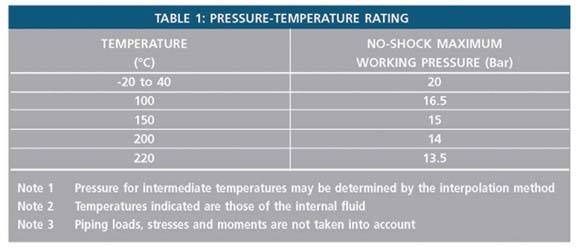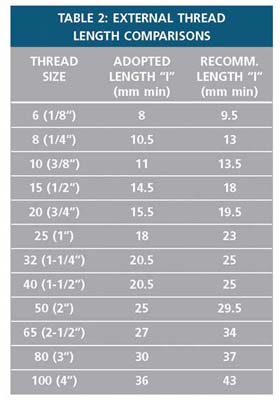
For many years there has not been a Standard to cover the low pressure stainless steel cast pipe fittings commonly used in Australia and other countries around the world.
These are commonly termed “150lb” or “BSP” pipe fittings. In most cases the fittings that have been supplied were a mismatch of various Standards.
The fittings were dimensionally in accordance with a number of American Standards, whilst British Standard threads were used. This led to the fittings having threads that in some cases were non-compliant - basically there was insufficient length to accommodate the thread.
ASSDA, through its Technical Committee, identified this problem in the early 90s and through the publication of ASSDA’s Technical Bulletin No 1, highlighted the problems to the Australian market. ASSDA also looked for a mechanism to have these problems rectified.
ISO 4144 "Pipework - Stainless Steel Fittings Threaded in Accordance with ISO 7-1"
After investigating the alternatives it was decided that International Standard ISO 4144 could be the conduit to rectifying the problems. ISO 4144 in its 1979 form covered most of the committee’s concerns, but it did not allow for cast fittings - only wrought stainless steel.
After correspondence with the Australian and International Standard bodies, it was ascertained that ISO 4144 was due for revision, which presented a golden opportunity to have the standard rewritten to cover all of the Technical Committee’s concerns.
ASSDA was invited to represent Australia on the committee established to review the Standard and actively took part in the full process of its revision. Not all of the Committee’s recommendations were accepted. Finally, in early 2003 the new Standard was published.
What has been achieved?
The major improvements that have been adopted in the new Standard are:
a. The use of castings as well as wrought materials.
b. All cast fittings are to be properly heat-treated by solution annealing.
c. The reduction in dimension, a more economical fitting.
d. The thread standards allowed have been clearly defined.
e. An introduction of pressure-temperature ratings for application of the fittings.
f. The inclusion of eight new types of fittings into the Standard.
g. The inclusion of DN 100 (4”) fittings.
Now that ISO 4144:2003 allows for the use of castings, Australia finally has a Standard that covers the products that have been in common use for many years.
The requirement that all castings are to be fully heat-treated will alleviate some of the corrosion problems that have been encountered in the past.
The dimensions of the fittings have been revised dramatically, thus giving a lighter and more economical fitting.
The wall thickness is the major dimension that has been reduced and it can be reduced by a further 20% if the fitting is made from wrought material.
ISO 7-1 sealing pipe threads are to be used on all fittings. The external and internal threads are to be tapered, but the internal threads may be parallel. The only exception to this is the threads on the Unions and their mating nut, which are allowed to have a variety of parallel threads.
Pressure temperature ratings for application of fittings have been specified (refer to Table 1).

ome fitting types supplied into Australia were not covered in the old ISO 4144 Standard.
Eight new types have been included in the new Standard: these are 90° Reducing Female Elbows, Reducing Female Tees, 45° Equal Female Elbows, 90° Male x Female Elbows, Crosses, Reducing Nipples, Male x Female Unions and Male x Male Unions.
With the inclusion of the DN 100 (4”) fittings, the Standard now has a comprehensive range of products.
Some Disappointments with the New Standard
In the new Standard, apart from some minor editorial errors, there are two points of concern to the ASSDA Technical Committee.
Firstly, the new wall thicknesses that are stated as minimum could lead to a product being supplied that may not meet the expectations of the customer.
Even though the Standard allows for thin wall product, such thin walled fittings could be subject to distortion during the threading process or during installation. Care must be taken that this does not occur.
The second concern within the Standard is the length of the minimum external thread that has been adopted. The title of ISO 7-1 is “pipe threads where pressure tight joints are made on the threads”.
The minimum length specified can accommodate a thread that seals if it is manufactured to close tolerance. Care is required in manufacture to achieve this outcome.
Although it was recommended to the International Committee that it accept external thread lengths that could accommodate a thread at both ends of the tolerance range, the Committee did not adopt these recommendations.
Table 2 highlights the external thread lengths that were adopted compared to the external thread lengths that were recommended by Australia.

Conclusion
ASSDA believes minimum thread length is a concern to all suppliers and users of these fittings and care should be taken in their selection.
If mating fittings do not seal on the threads and interfere with the washout they may leak.
It is recommended that fittings should only be sourced from reputable and experienced manufacturers and supplied to ISO 4144:2003.
Overall, the Standard is a considerable improvement on what was available, and with care in the selection, the end user will be in a more certain and much safer environment than in the past.
Credits
This article was written by Kim Burton, Group Supply Manager of Prochem Pipeline Products Pty Ltd and an ASSDA Technical Committee member. ASSDA also acknowledges the contribution of Technical Committee member Peter Moore, Technical Services Manager of Atlas Specialty Metals, in the development of this article.
Download Technical Bulletin (April 1997 - pdf 920k)
This technical article featured in Australian Stainless magazine - Issue 27, February 2004.